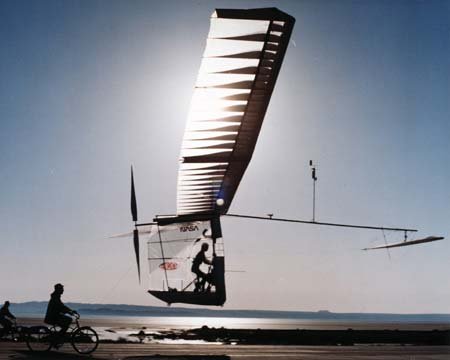Bicycle Kick (10)
By:
May 21, 2010

From the League of American Wheelmen’s Good Roads, v. 5 (1894):
The riding of a bicycle to-day is very common, and we are apt to wonder that this grand art was not brought about many years ago. There is no doubt in my mind that the bicycle will be the means of bringing a machine suitable for navigating the air. I do not mean to say that we would care to sail more than a few inches, or at the best more than a few feet from the ground, until we became experts with the bicycle flying machine. However, in order to accomplish this evolution, good roads and a first-class surface are very essential.
This matter of flying, however, can be brought about in a short time. It will require a great deal of practice, which may be carried on without danger to the operator, as the flights will start at a low rate of speed, propelling the machine faster and faster until the bicycle and rider have attained sufficient speed so that the pressure of the air under the aero-plane will be sufficient to raise him and his mechanism one or two inches from the ground; the power which has been transmitted to the bicycle will be shifted to the flying machine, and the energy of the operator will be used to drive the propellor which pulls the machine along through the air. When the operator wishes to descend, he pitches himself a little forward and the wheels of the bicycle come in contact with the ground, and the speed is gradually decreased as would be done in the riding of a regular safety.
This kind of experimenting should be tried on smooth roads where there would be no danger to the operator, as it is not convenient to go to a hill, or to have a tower built to jump from to obtain a start; nor would the waiting for a current of air strong enough, be practical. It is quite necessary to have an apparatus which can be started in all kinds of weather and run with safety.
The connection between cycling and powered flight is not trivial. Before the epochal flights at Kitty Hawk, Orville and Wilbur were innovators in their Dayton, Ohio bike shop, where through the 1890s they fitted primitive airfoils to bicycles and conducted wind tunnel tests. One of the twentieth century’s signature technologies was born in a shop festooned with the fleet frames of safety bikes.

It became customary in the twentieth century to goggle at the rapid advance of aeronautic technology, which in one lifespan evolved from the wire-and-fabric Wright Flier to supersonic jets plying the stratosphere. But perhaps the true apotheosis of the Wright Brothers’ machinations occurred on August 23, 1977, when Paul B. MacCready’s Gossamer Condor, piloted by amateur cyclist (and future Mars explorer) Bryan Allen, flew a mile-long course in California. Two years later, Allen crossed the English Channel in another version of the craft, which ascended to an altitude of 5 feet at speeds up to 18 m.p.h — powered, via cogs and chain, by Allen’s pedaling feet.

Tenth in a series of twelve.
